📈 1. Get 1% Better Every Day: Aim for tiny daily improvements to see big changes over time
How many of us have set big goals, usually around New Year’s, about all the bad habits we will break free from and all the good habits we will form? But then what happens? A few weeks later, we always seem to fall back to where we started, and no closer to becoming the person that we really want to be.

Why do our efforts at personal change so often fail? James Clear says it’s because we’re taking the wrong approach with the traditional goal-oriented mindset. So this first part of “Atomic Habits” focuses on how we can get 1% better every day, and in doing so change our lives.
Here are the key points:
- 📈 The power of 1% adjustments. Most people dramatically underestimate the impact of small daily improvements made over time. Changing the trajectory of our lives by 1% each day – through building positive habits – can transform your life entirely in 2, 5 or 10 years in the future. But most often, the dramatic effect of these small, seemingly unimportant changes only becomes obvious when we are looking backwards in time.
- 🛫 A great illustration – Picture an airplane taking off from New York and travelling to Los Angeles. Now imagine someone adjusted the angle of the plane by just 3° at takeoff. Guess where the plane would end up? It would land in Tijuana Mexico, rather than Los Angeles.
- 💰 Habits work like compound interest. James Clear says habits are essentially the compound interest of the self improvement world. When you invest money, the power of compounding can make it grow into a much larger amount than most people would expect. That is why investing a little bit each month is how most people become wealthy, rather than aiming for one massive payday. In the same way, by improving our daily habits just a little bit each day, our outcomes and success can end up much greater than intuition would predict.
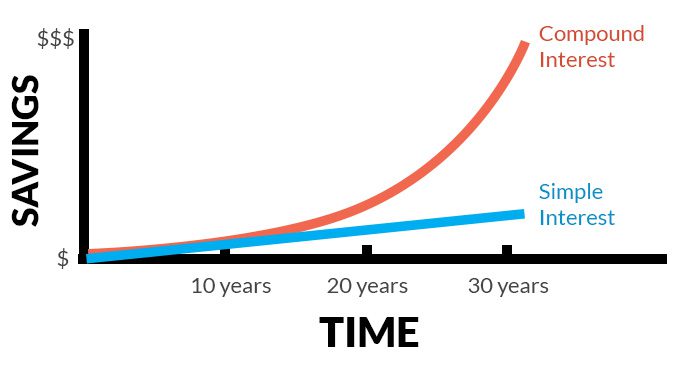
Here’s some surprising math about the power of compounding: If you get just 🌱 1% better every day, than after one year you will be 37.38 TIMES better than how you started! 🚀
- 😞 Overcoming “the valley of disappointment.” In any endeavour, we expect progress to be linear. But what usually happens is that our success follows a compounding curve – you make very little progress in the first few months, and then suddenly you your improvement shoots upwards. The problem is that most people stop out of disappointment before they reach that critical point. So the trick is to continue onwards even when we’re not seeing any real signs of success.
- ❄️💧 A great analogy – a melting ice cube. if you raise the temperature around an ice cube from -20°C to -10°C and even to -5°C, nothing happens. It is only if you continue raising the temperature above 0°C – the freezing point – that suddenly you will see the ice cube begin to melt.
- Habits are compound interest. By getting just 1% better every day, you will end up 37.78 times better by the end of the year.
According to James Clear, habits are like compound interest because they .
Guarantee instant success
Decrease risk
Demand perfection
Multiply our results
This first principle is echoed in another modern best-selling book “The Psychology of Money,” which emphasizes building wealth through long-term thinking over the pursuit of getting rich quick. Author Morgan Housel channels the investing mindset of Warren Buffett when he says “There is no reason to risk what you have and need for what you don’t have and don’t need.”
He concludes that by harnessing the power of compounding and being patient about outcomes, you will almost always accumulate more wealth than 99% of the people who chase short-term gains.
Read our summary of The Psychology of Money by Morgan Housel
⚙️ 2. Systems Vs. Goals: Prioritize your daily processes instead of just setting goals
Conventional wisdom tells us to focus on setting either ambitious or realistic goals, but James Clear argues that’s completely wrong. Instead, he introduces the idea that systems are what we should focus on.

Focus on ⚙️ systems, not 🎯 goals. While goals are the outcomes we want, systems are about the daily processes that will eventually lead to those outcomes.
📖 For example, your goal may be to write a book, but your system would be sitting down to write for one hour every day. With a systems focus, you would be thinking about how to make your daily writing sessions 1% better every day – such as by minimizing distractions to work more deeply.
More key points:
- 📊 Systems are better for making progress. With systems, we become more focused on getting 1% better every day, rather than taking massive action towards a goal once in a while, which generally fails. James Clear also points out that winners and losers both have the same goals, therefore having goals can’t make the difference between our success and failure.
- 🚴 A striking example – The British cycling team transformed from losers into Olympic gold medalists and Tour de France winners not by setting bigger goals, but by focusing on tiny improvements. They focused on becoming 1% better daily in everything from what they ate to how they slept to how they tuned their bikes.
- 😌 Systems provide sustainable motivation and satisfaction. With a goal, there is a finish line. But with systems there is no finish line, and that’s actually a good thing. You can simply focus on becoming a little bit better than you were yesterday.
- 🏃♂️ For example, let’s say your goal is to run a marathon. Then you do it. What happens after? You’ll probably lose motivation to continue running. But if you focus on becoming a 1% better runner every day, then you will continue to have motivation to exercise and stay in shape.
- Focus on systems over goals, those daily processes you follow to reach your goals. This approach provides more sure progress and lasting motivation.
To focus on systems over goals, it's essential to that make your desired goals inevitable.
Set bigger goals
Establish daily routines
Sustain your motivation
Take massive action
Focusing on systems means thinking long-term, and a big part of that is setting up habits and routines that are sustainable, kind of like what the classic book “The 7 Habits of Highly Effective People” talks about.
There’s a story in the book about a magical goose that lays golden eggs. The owner, getting greedy, decides to cut the goose open to get all the eggs at once but finds nothing inside. He ends up losing everything – the goose and the future eggs. It’s a lesson about not rushing for quick success but taking care of what helps us succeed over time.
🔄 3. The Four Laws of Behaviour Change: Make your good habits obvious, attractive, easy, and satisfying
So, what is a habit exactly? A habit is a behavior that is repeated often enough that it becomes automatic. Habits are useful because they help us take action while saving mental energy. In this section, we’ll break habits down into 4 parts and then show you how to ‘hack’ each of these parts to gain greater control of your behaviour.
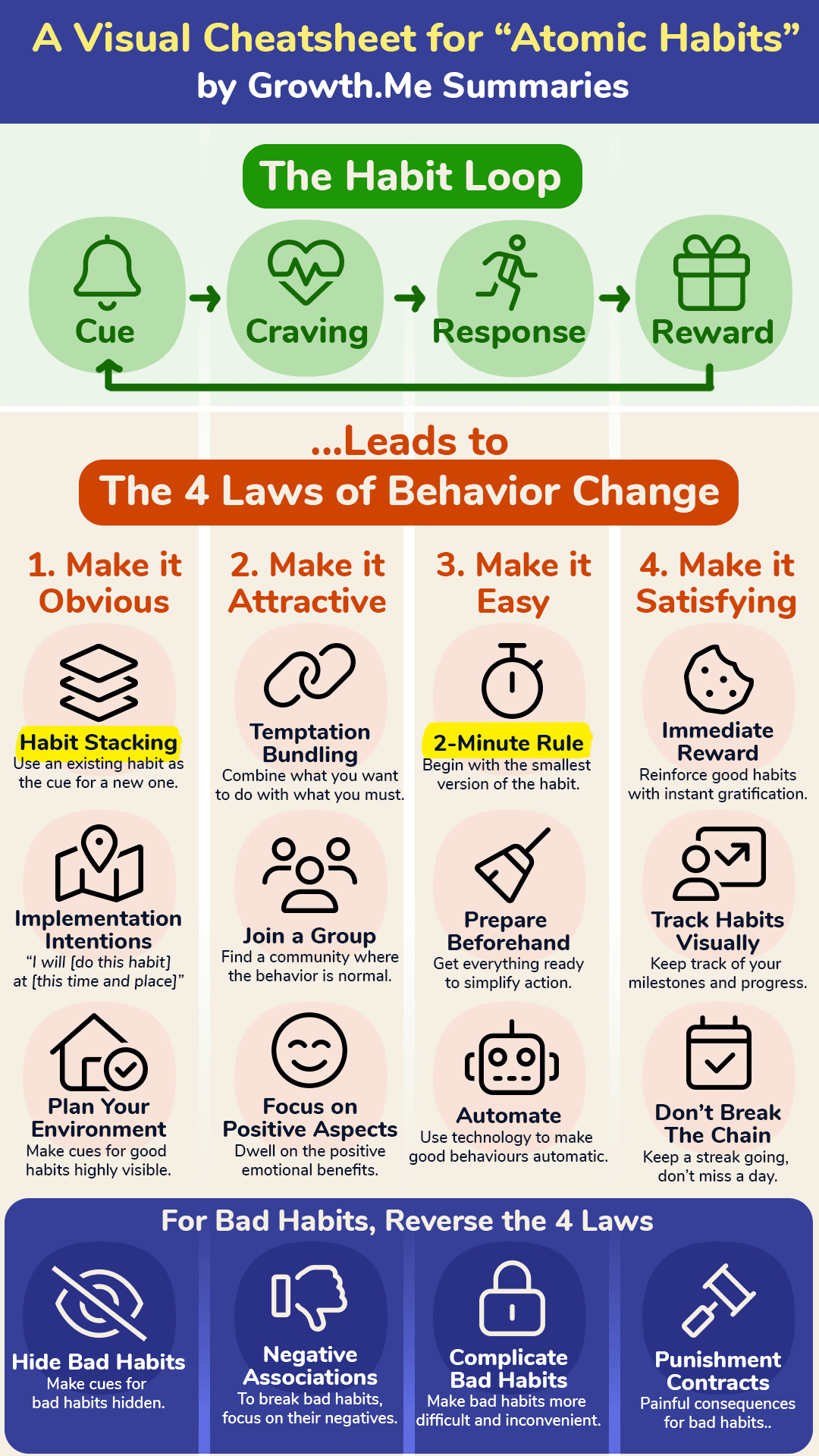
Every habit follows a 4-step habit loop that reinforces it:
- 🔔 Cue. The initial trigger for a habit, coming from anything around you like an object, environment, time of day, or even a person. Example: Hearing your phone beep causes your hand to immediately reach for it to check it for new notifications.
- 🤤 Craving. The feeling that motivates you to perform the habit. Example: Feeling stuck for a moment while studying causes you to check social media for updates to feel less frustrated.
- 🏃♂️ Response. The actual habit, or repeated behavior. Example: Picking up your phone and starting to scroll through social media or messages.
- 😊 Reward. Feeling better after, which reinforces the habit. The reward is what teaches us to remember and repeat this habit loop in the future. Example: Seeing a funny video or receiving a message from a friend, which makes you feel happy and connected.
This brings us to The 4 Laws of Behavior Change, which we can use to make good habits stick. Each law is based on one part of the habit loop. Here’s a fast overview:
- 🔍 Make it obvious. (Cue) Make the cues that triggers the good habit more visible in your environment. The more obvious they are, the more likely you are to notice them and initiate the habit loop. Example: Placing water bottles on your bedside table, kitchen table, and work desk so you remember to drink enough water.
- 🌟 Make it attractive. (Craving) Strengthen the craving, the motivation to act, by associating the habit with positive feelings and appealing rewards. Example: Working out to your favourite music or podcast to make exercise more enjoyable.
- 🎉 Make it easy. (Response) Increase your likelihood of taking action by reducing the effort required and making the habit simpler to do. Example: Preparing a week’s worth of healthy meals in advance to eliminate daily cooking decisions.
- 😋 Make it satisfying. (Reward) Make sure the habit provides an immediate and satisfying reward, making it more likely you’ll repeat the habit loop. Example: Treating yourself to a relaxing shower or a favourite snack after exercising, making the effort feel worthwhile.
- 🔄 To break bad habits, just flip the laws. Make the bad habit invisible, unattractive, difficult, and unsatisfying. For example, keeping unhealthy snacks not on the table, but in a place that is hidden and difficult to reach.
Next, we’ll be diving much deeper into each one of these laws. We’ll be learning about some advanced tactics for each law, so you can more effectively form good habits and break bad habits.
- A habit is a behavior we’ve learned to repeat for a reliable reward. Each one follows a habit loop of cue-craving-response-reward, which reinforces the habit.
- The 4 Laws of Behavior Change correspond to these – we can make good habits stick by making cues more obvious, cravings more attractive, responses easier, and rewards more satisfying.
Which of the 4 Laws suggests reducing the effort required to perform a habit?
Make it obvious
Make it attractive
Make it easy
Make it satisfying
This concept of “habit loops” isn’t new. James Clear is simply building on ideas that have been around for ages. Charles Duhigg’s book “The Power of Habit,” published in 2012, introduced us to a simpler habit loop: cue, routine, and reward.
Going further back, 70 years ago, psychologist B.F. Skinner explored how behaviors in animals follow a sequence of “stimulus, response, and reward.” And even before him in 1898, Edward Thorndike experimented with cats in puzzle boxes, noting how they got quicker at escaping, laying early groundwork for understanding how habits form.
🔍 4. Make it Obvious: Make the cues for good habits more visible, and hide bad habits
Cues play a crucial role in forming good habits and breaking bad ones. By making the cue for a good habit more prominent and noticeable, we can increase the likelihood that we perform that habit. On the other hand, we can hide triggers for bad habits to help us break them.
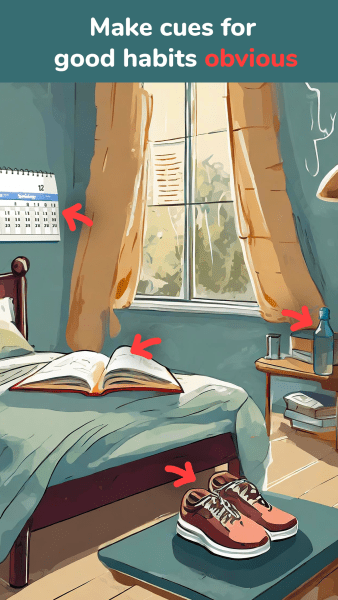
Some key points:
- 📝 Habits scorecard. The first tool is to write down all of your daily habits on one page, from the moment you wake up until you go to sleep. Then label each habit as positive, negative, or neutral – based on whether it helps you be the person you want to be. This habit scorecard is important because our daily habits are so automatic, so we must first become aware of them. Think about what cue may trigger each habit.
- 🏠 Environment beats motivation. James Clear says that motivation and willpower are overrated – our surroundings tend to have a stronger influence on our behavior. We can design our environment to make the cues for good habits more obvious, making us more likely to repeat them.
- 🎸 Example: Keep your guitar in your living room, right where you’ll always see it, if you’d like to practice more often. If it is hidden away in a closet or the garage, then it’s easy to forget about it. As they say, out of sight means out of mind.
- 🥞 Habit stacking. You can use an existing habit as the cue for a new habit that you want to adopt. Use this formula: “After [current habit], I will do [new habit].” You can even chain multiple good habits together like this to create a positive routine. For example, “after turning off my morning alarm, I will do 10 push-ups, then read one page of a book.”
- 📅 Implementations intentions. Most people have vague goals about what they want to achieve, such as “get in shape.” Research shows that being clear about when we will perform a new habit makes it far more likely that we will actually do it. Use this formula “I will do [this behaviour] at [this time] in [this location].” For example, “I will stop by the gym and work out for 30 minutes when I’m driving home from work.”
- 🚫 Make bad habits invisible. The inverse, or flip side, of this law is to make bad habits less obvious in your environment. Rather than relying on willpower, it’s a lot easier to avoid a bad habit by making the cue for it invisible. For example, if you’re getting distracted by social media notifications, then it may be a good idea to put your phone in another room while working.
- The first rule for changing habits is “Make it Obvious.” It teaches us to keep reminders of good habits where we can see them and hide the cues that lead to bad habits.
- We can make a new good habit stick better without relying on willpower through: deliberately planning our environment, using a current habit as the cue for a new one, and being clear about when and where we will do it.
Which concept involves linking a new habit to an existing one in a specific sequence?
Routine chaining
Sequential actions
Habit stacking
Action pairing
In the book “Hooked,” technology consultant Nir Eyal applies the psychology of habit formation towards designing products and apps that are addictive. He reveals many of the tricks that big tech companies use to keep our eyes glued to their apps. One crucial tool for product engagement are cues or triggers that nudge us to return to the app.
There are external triggers, like a notification or email, that cause users to check the app. But there are also internal triggers – feelings of boredom or loneliness can serve as spontaneous cues, leading people to open their favourite app in search of connection or entertainment. The most successful apps deliberately try to create these internal cues in us so using their app becomes a seamless part of our daily routines.
🌟 5. Make it Attractive: Strengthen your motivation with the power of dopamine and community
The next part of hacking your habit loop is all about the craving, which is your anticipation of a reward after completing the habit. We can have stronger and more sustained motivation towards positive habits by making them more attractive. How? By tapping into our brains built-in reward system.

Key points:
- 🧠 Dopamine fuels motivation. Your brain contains dopamine, a neurotransmitter, which basically means it is a chemical signal in your brain. Dopamine is often called the pleasure molecule, but it can be more about anticipation of pleasure. Our dopamine levels rise when we begin craving the reward of some action, and we become motivated to act to get the reward. For example, we get dopamine spikes in our brains before and while we use social media, eat junk food, or take drugs, which is why all those activities are so habit-forming.
- 👥 Core human drives. If you want to understand why some bad habits hook us so strongly, it’s because they tap into core human drives. We all have some basic motivators that we have been programmed to respond to through millions of years of evolution, such as getting food and water, finding love and reproducing, feeling social connection and belonging. So our brain did not evolve with the desire to spend hours on social media, but to feel connected.
- 🤝 Temptation bundling. This is a technique where you can make a habit more attractive by pairing it with something that you want to do. For example, one engineer connected his stationary bike to his TV, so he could only watch Netflix while he was exercising. You can also do the activity you want to do as an immediate reward after the activity you need to do, such as eating a tasty protein bar after working out.
- 🌐 Community influence. We have a strong need to belong, and that means our habits are greatly influenced by the groups we are part of. So one of the best ways to adopt a new habit is to join a group where doing that activity is considered normal. For example, if you want to read more, then join a book club.
- 😊 Positive associations. Finally, if you want to make a habit more attractive, focus on associating it with a positive experience. For example, think of cleaning your room as bringing mental clarity, rather than wasting time.
- 🚫 Make bad habits unattractive. Link your bad habit with negative experiences. For example, the book “The Easy Way to Stop Smoking” by Allen Carr talks a lot about the negatives of smoking, such as bad breath. When people focus more on those downsides, it becomes less attractive and they are less likely to continue.
- Make your good habits more appealing by leveraging the brain’s dopamine system for motivation and surrounding yourself with a supportive community.
- Key tactics include temptation bundling to pair desirable activities with necessary habits, creating positive associations to make habits more attractive, and consciously making bad habits seem less appealing by focusing on their negative aspects.
What best describes the tactic of temptation bundling?
Exercising before eating
Watching TV to relax
Eating protein bars regularly
Pairing workouts with Netflix
The best book I’ve read on the science of dopamine is “Dopamine Nation” by Dr. Anna Lembke, Director of Stanford’s Addiction Medicine Clinic. She clarifies that while dopamine is natural and essential for motivation, a problem arises in our digital society where we’re constantly exposed to high-dopamine stimulation.
This situation leads us to compulsively over consume social media, fast food, and even pornography – resulting in a tolerance to dopamine that dulls our ability to enjoy pleasures. Dr. Lembke says, “The paradox is that hedonism, the pursuit of pleasure for its own sake, leads to anhedonia, which is the inability to enjoy pleasure of any kind.”
If you want to take back control of your life and increase your capacity to do hard things, a key first step she recommends is a 30-day dopamine fast. This means abstaining from your compulsive habit for a month, then seeing how you feel afterwards.
🎉 6. Make it Easy: Reduce the effort needed to start and maintain habits
The next part of “Atomic Habits” deals with the third part of the habit loop called the response – the sequence of actions you do during the habit. This is all about the question: How can we increase the likelihood that we will continue with our habits? The answer? Make it easy.
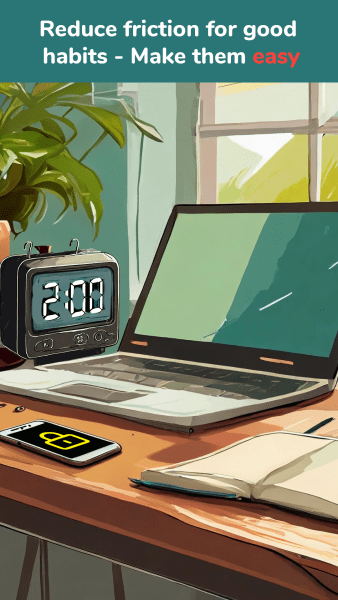
Key points:
- 🛌 The Law of Least Effort. People naturally gravitate to the path of least resistance. That’s not called laziness, that’s simple part of human nature, a smart strategy of saving energy. But it means the easier you can make it for you to start and repeat a new habit, the more likely it is you’ll stick with it.
- 🔁 Repetition over perfection. When it comes to building habits, consistency is king. How long it takes to form a new habit is based more on the number of repetitions you have done, than on how many days since you started.
- 🛠️ Reducing friction. Anything you can do to make starting your habit feel smoother will increase your likelihood of success. Here are some good strategies.
- ⏱ 2-Minute Rule. To overcome procrastination, start a new habit with the smallest version of that habit, find an action that takes almost no effort. For example, instead of trying to read 10 pages a day, begin with reading for 2 minutes each day. Then slowly, over time, as the habit loop becomes solid, you can increase to 2 pages, then 3, 5 and 10.
- 🏠 Prepare your surroundings. Arrange your home so that good habits require no planning to complete. For example, if you wanted to run in the morning, then make sure your running shoes and clothes are ready to go beside your bed.
- ⚙️ Use one-time automation. When you can, then it’s best to set up good actions to happen automatically, so that good habits no longer require willpower. A perfect example is saving money – banks allow you to set up automatic deposits into your retirement and investing accounts.
- 🚫 Make bad habits difficult. The reverse of this is to increase the effort needed to engage in bad habits. Unplugging the video game console from the TV and putting it into a closet after each use makes it impractical to play games compulsively.
- Start and keep habits by making them super simple. Use the 2-minute rule: if it’s a habit that takes just two minutes to do, start with that. Organize your space so it’s easier to do your habit every day without thinking too much. And if you can, make your good habits automatic so you don’t even need to use willpower.
When you're forming a new habit, says to start with actions that are small and effortless.
The 2-Minute Rule
The Law of Least Effort
The Minimum Viable Habit
The Repetition Method
Another great book is “Tiny Habits” by B.J. Fogg, the director of the Behavior Design Lab at Stanford. He echoes the same message, “The easier a behavior is to do, the more likely the behavior will become habit.” And his method is to begin each new habit with a small action that you can complete in 30 seconds or less.
Our summary of Tiny Habits is coming in the future
😋 7. Make it Satisfying: Add immediate rewards to make sticking to your habits more enjoyable
if you want to make your good habits stick then Atomic Habits says you should make them immediately rewarding.

This is James Clear’s golden rule of behaviour change: immediately reward the behaviours you want to be repeated, and immediately punish the ones you don’t.
You see, in almost everything you want to do, there’s a big mismatch between instant and delayed rewards. Most good habits feel kinda difficult right now, but we do them because they make us feel great later on. Well bad habits are the opposite – they give us pleasure now, but have a longer term cost we usually want to avoid. A simple example: studying feels hard, but makes a smarter.
Key strategies to make habits satisfying include:
- 🍭 Add instant gratification. When a habit is good for you in the long-term, it is very useful to add immediate pleasure after doing it. This reinforces the habit with strong mental conditioning, making it more likely to stick. For example, eating a tasty snack after doing meditation.
- 📊 Visual Habit Tracker. Use visual tools like wall charts or journals to mark your progress with milestones. This gives a tangible feeling of achievement that can be very motivating. For example, Arnold Schwarzenegger got hooked on lifting weights by marking down his reps and sets on a blackboard, in a small gym in Austria.
- 🔗 Don’t Break the Chain Method. Show up for the habit every single day, at least a little bit. Even on tough days, do an easier version of your habit to keep the streak alive. It’s all about avoiding those “zero” days when we do nothing – too many of those in a row will kill a habit. And if you miss one day, make sure you never miss two days in a row. Example: If you’re too tired to go to the gym, do 10 minutes of light exercise at home.
- 📝 Punishment contract. Plan punishments in advance for skipping your most important habits. Find an accountability partner, you’ll often continue the habit to avoid disappointing someone. You can also add a monetary consequence, like giving them $10 for every day you skip reading.
- To make habits stick, make them immediately rewarding. This helps balance that mismatch between instant and delayed gratification of good habits. Key strategies include: tracking your progress visually, maintaining your habit streak, and setting up punishments for missed habits – all to ensure consistency and motivation.
An example of a Visual Habit Tracker is a .
Wall chart
To-do list
Written strategy
Calendar Schedule
🦸 8. Identity-Based Habits: Focus on who you want to become to drive lasting change
Most personal development books emphasize goals, outcomes, and processes. But James Clear argues the deepest and most lasting form of change happens when we shift our identity, who we believe we are.
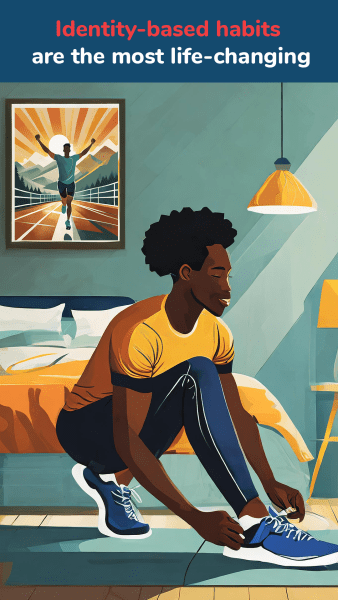
There are 🥞 3 Layers of Behavior Change:
- 🎯 Outcomes: The first, most superficial layer of change is about the results you aim for, like losing weight or finishing a book.
- 🛠️ Process: The deeper middle layer is about the actions you take, such as your workout routine or daily writing habit.
- 🦸 Identity: Finally, the deepest layer of change is about your beliefs and self-perception that guide your actions and thoughts.
So instead of making it your goal to run a marathon, make it your aim to become a runner. When a behavior becomes part of your identity, then your habits will naturally align with it, leading to more sustainable progress.
- Behavior change has 3 layers: outcomes, process, and identity. Changing how we see ourselves tends to provide the strongest transformation.
If you wanted to be a published author, then identity-based habits say you should focus on .
Writing a book
Networking with authors
Taking writing classes
Becoming a writer
- Identify Small Improvements: Pick one minor habit to get 1% better at today, like drinking one more glass of water.
- Focus on Daily Systems: Instead of aiming to lose 15 pounds, plan daily nutritious meals and enjoyable exercise.
- Place Habit Reminders: Keep visual cues for your new habit in sight, such as placing a book on your pillow to read before sleep.
- Combine Habits with Pleasures: Link a desired habit with a favourite activity, like listening to audiobooks while cleaning.
- Simplify Habit Initiation: Prepare for your habits in advance, like setting out gym clothes for the morning workout.
- Reward After Habits: Give yourself a small reward immediately after a habit, like a piece of dark chocolate after studying.
- Reframe Your Identity: Write “I am” statements related to your new desired habits, such as “I am a musician.” Then make decisions based on this identity: what would a musician do daily?



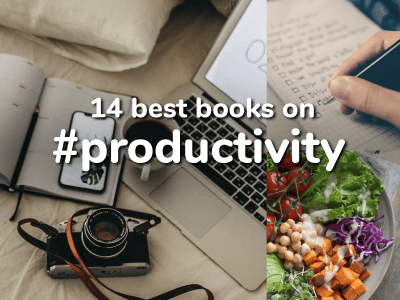
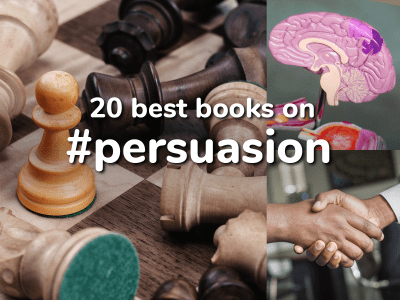
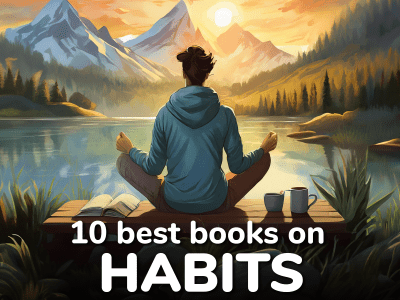
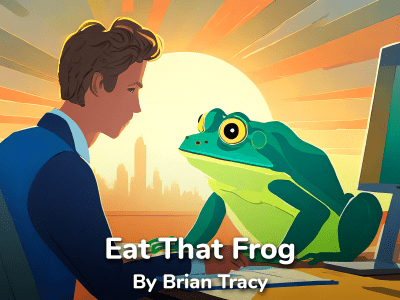
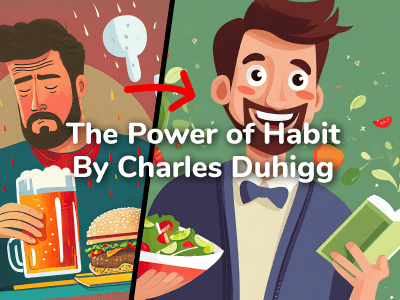


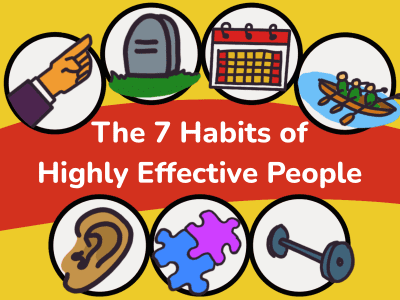



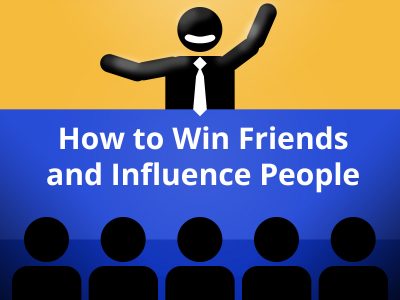
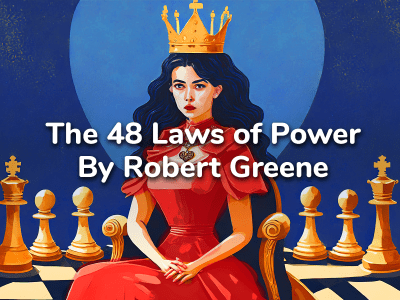






Community Notes